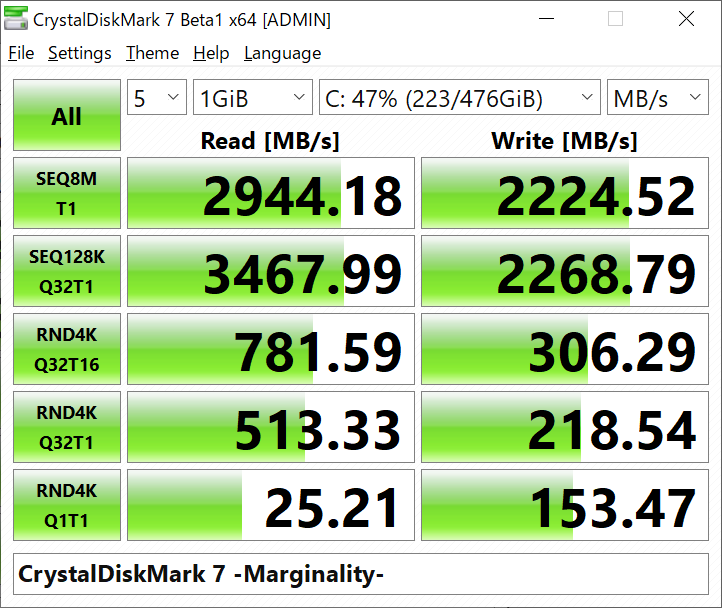

So, with an empty drive, you get around 300GB’s worth of writes at peak performance before the underlying performance of the TLC NAND chips is exposed.
#DISKMARK RESULTS PC#
Likewise, don’t expect big gains in system-wide measures of performance like PC Mark 10.įinally, the new SN850X’s SLC cache allocation hasn’t changed. The 4K random access results are a little disappointing, showing little to no improvement.

Elsewhere, the gains are less obvious, albeit the SN850 was already a great drive. The new drive hits just 58☌ under sustained load. Reduced operating temps are another clear benefit of this new drive. Only 2TB models, including the aforementioned SK Hynix P41, are quicker. The CrystalDiskMark results are therefore just over the claimed 7,300MB/s for reads and likewise clear of 6,300MB/s for writes, making this a very quick 1TB drive. What we can say for sure is that peak sequential throughput is pretty much in line with WD’s numbers. In reality, you’re getting hundreds of gigabytes of writes daily for five years plus, either way. Not bad, though the SK Hynix cranks out 1.4M and 1.3M read and write IOPS.Īs for write endurance, this 1TB drive is rated at 600TB and thus the same as both the old non-X and several other big-brand 1TB drives like the Samsung 980 Pro, albeit the SK Hynix monster inevitably has the edge with a 750TB rating. WD says the revised X model is now good for 1.1M and 800K respectively. Moving on to IOPS, the old 1TB SN850 notched up a claimed 1M reads and 720K writes. CrystalDiskMark benchmark results When using the All option, the tool will run all the available tests, including the sequential reads and writes and three. That’s very much in the same ballpark as the SK Hynix drive. So, the question is whether it now has what it takes to compete with Gen 4 speed freaks like the SK Hynix Platinum P41.įor this 1TB model, WD reckons that write speeds have been bumped from 7,000MB/s to 7,300MB/s, while reads take a bigger leap from 5,300MB/s to 6,300MB/s. Nevertheless, the new SN850X sports a higher claimed performance than before. The drive’s TLC flash memory chips have likewise been upgraded from 96-layer TLC chips to newer 112-layer tech, though that’s still some way behind the fancy new 176-layer NAND from the likes of Micron and SK Hynix. My first pass was 6897 Read 6291 Write and my.

The combination of results from the sub-tests isn’t covered above. Not sure of the accuracy of the results but it did in fact complete all passes in testing the 1GiB setting. Some of the tests actually contain a bunch of sub-tests. There is one result where smaller numbers are better (memory latency). Crystal DiskMark can measure sequential reads/writes speed, measure random 512 KB, 4 KB, 4 KB (Queue Depth 32) reads/writes speed, has support for different types of test data (Random, 0 Fill, 1. Rated performance: 7,300MB/s read, 6,300MB/s write We penalize some results in cases like this.


 0 kommentar(er)
0 kommentar(er)
